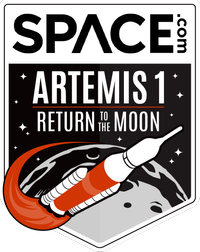NASA's Artemis 1 moon rocket gets Aug. 29 launch date
The first three opportunities for lunar launch are in late August and early September, pending tweaks to the megarocket.


NASA hopes to get its moon megarocket off the ground as soon as late August.
NASA is working toward three "placeholder" launch dates for Artemis 1, an uncrewed test flight around the moon that serves as a keystone in testing for future human missions: Aug. 29, Sept. 2 and Sept. 5. These dates are pending repairs and tweaks, however, to the Space Launch System rocket and related systems in light of results from a "wet dress rehearsal" June 20 that NASA declared a success, officials said in a teleconference with media held on Wednesday (July 20).
"It's not an agency commitment," Jim Free, NASA's associate administrator of exploration systems, said of the interim launch dates. NASA will announce a more firm commitment about one week before the launch, he said, when the agency completes its standard flight readiness review of the Artemis 1 stack, including SLS and the Orion capsule riding atop the rocket.
Related: NASA's Artemis 1 moon mission explained in photos
The interim dates in late August and early September, however, are what "the team is working to, and has a plan for," Free added. "But [we have] a lot of work left of things that we'll have to do, and probably learn from, including close-outs."
Close-outs are interim approvals on the key systems that are required for launch, flight to the moon and back for a splashdown on Earth. NASA has a checklist of items to perform on the SLS stack before it leaves the Vehicle Assembly Building at NASA's Kennedy Space Center in Florida, where work is ongoing to address issues encountered during the wet dress rehearsal.
Artemis 1's most recent wet dress rehearsal was deemed good enough by NASA to proceed with launch preparations. Engineers fully fueled SLS for the first time during the three-day test. But the team encountered a hydrogen leak from the core stage's engine cooling system "umbilical" line.
Breaking space news, the latest updates on rocket launches, skywatching events and more!
During the test, the leak was resolved by closing a bleed valve in the hydrogen flow path. This workaround allowed the team to complete the wet dress, but it would not work during an actual launch because closing the bleed valve leaves engine thermal systems without proper regulation. (Operators ran a software "mask" during the test to allow the countdown to proceed, while letting the ground launch sequencer flag the temperature variance as it is designed to do.)
Next came a roll-back to the VAB on July 2 for maintenance, including repairs to the quick-disconnect component on the aft SLS umbilical blamed for the hydrogen leak. Technicians are also doing vehicle inspections, repairing the hydrogen leaks, replacing seals on the core stage, installing flight batteries, stowing payloads and doing power tests on Orion, and performing software loads on the SLS core stage and upper stage.
NASA officials said during the call on Wednesday that they are making good progress on these repairs, but proceeding carefully to make sure Artemis 1 is ready before letting it leave the building. Personnel have already replaced a navigation and control assembly unit and are testing batteries and checking over the interim cryogenic propulsion stage that will give the Orion capsule a kick toward the moon during its mission.
Related: NASA's Artemis program of lunar exploration
Artemis 1 must pass a rigorous set of operation maintenance requirements "to say that the vehicle is ready," said Cliff Lanham, senior vehicle operations manager of NASA's exploration ground systems program.
Only once the SLS stack completes those tests inside the VAB will it be authorized to move to the pad, which may happen as soon as Aug. 18 if all goes well.
While the entire set of tests is lengthy, some key ones the agency is watching include tests of the flight termination system of SLS, the rocket's engine section, the rocket's core stage forward skirt that houses flight computers and avionics systems, and the Orion spacecraft.
The three launch attempts each present different mission durations and launch timings, NASA officials said. The Aug. 29 launch opportunity would open at 8:33 a.m. EDT (1333 GMT) and last two hours; assuming Artemis 1 launches successfully, the Orion capsule would return to Earth after 42 days for a splashdown on Oct. 10.
Sept. 2 offers a two-hour launch window that opens at 12:48 p.m. EDT (1748 GMT); in this scenario, Artemis 1 would return 39 days later on Oct. 11. The last opportunity, Sept. 5, includes a 1.5-hour launch window starting at 5:12 p.m. EDT (2212 GMT) and would see Artemis 1 return 42 days later, on Oct. 17.
As backup, the agency has identified several interim launch opportunities through mid-2023, in case weather or technical issues delay Artemis 1.
NASA discussed the progress of Artemis 1 on the 53rd anniversary of the Apollo 11 moon landing in 1969 that saw the first human steps on the moon. The agency hopes to return people there in 2025 or so, pending the results of Artemis 1 and a crewed orbital mission, Artemis 2, slated to launch no earlier than 2024.
Follow Elizabeth Howell on Twitter @howellspace. Follow us on Twitter @Spacedotcom or Facebook.

Elizabeth Howell (she/her), Ph.D., was a staff writer in the spaceflight channel between 2022 and 2024 specializing in Canadian space news. She was contributing writer for Space.com for 10 years from 2012 to 2024. Elizabeth's reporting includes multiple exclusives with the White House, leading world coverage about a lost-and-found space tomato on the International Space Station, witnessing five human spaceflight launches on two continents, flying parabolic, working inside a spacesuit, and participating in a simulated Mars mission. Her latest book, "Why Am I Taller?" (ECW Press, 2022) is co-written with astronaut Dave Williams.
